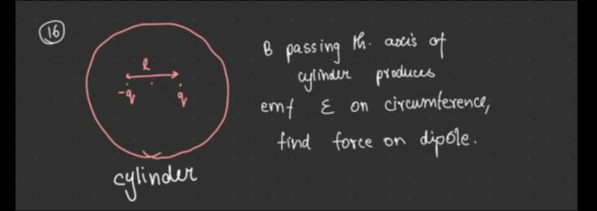Question
Question: To find the force on the electric dipole, we first need to determine the induced electric field `E` ...
To find the force on the electric dipole, we first need to determine the induced electric field E inside the cylinder due to the changing magnetic flux.
1. Induced Electric Field (E):
According to Faraday's Law of Induction, the induced EMF ε around a closed loop is related to the rate of change of magnetic flux Φ through the loop by:
ε=−dtdΦThe magnetic flux Φ through a circular area of radius R (the cross-section of the cylinder) is Φ=B⋅A=B⋅πR2.
So, the induced EMF on the circumference of the cylinder is:
ε=−dtd(BπR2)=−πR2dtdBFrom this, we can express dB/dt:
The induced electric field E at a distance r from the axis of the cylinder can be found using the integral form of Faraday's Law:
For a circular path of radius r inside the cylinder, the induced electric field E will be tangential (azimuthal) due to symmetry.
Solving for E:
The direction of E is azimuthal. Let's assume the cylinder's axis is the z-axis. The electric field vector at a point (x, y) in the xy-plane is given by:
(This corresponds to a clockwise field if dB/dt > 0).
2. Force on the Electric Dipole:
An electric dipole consists of charges -q and +q separated by a distance l. The dipole moment is $\vec{p} = q\vec{l}$, directed from -q to +q.
Let's assume the dipole is centered at the origin of the cylinder and oriented along the x-axis, as suggested by the diagram. So, -q is at (-l/2, 0) and +q is at (l/2, 0). The dipole moment is $\vec{p} = ql \hat{i}$.
The force on an electric dipole in a non-uniform electric field $\vec{E}$ is given by:
Here, $\vec{p} = ql \hat{i}$ and $\nabla = \frac{\partial}{\partial x}\hat{i} + \frac{\partial}{\partial y}\hat{j} + \frac{\partial}{\partial z}\hat{k}$.
So, $\vec{p} \cdot \nabla = (ql \hat{i}) \cdot (\frac{\partial}{\partial x}\hat{i} + \frac{\partial}{\partial y}\hat{j} + \frac{\partial}{\partial z}\hat{k}) = ql \frac{\partial}{\partial x}$.
Now, apply this operator to $\vec{E}$:
Since y and dB/dt are not functions of x:
3. Substitute dB/dt from (1) into (2):
Substitute $\frac{dB}{dt} = - \frac{\varepsilon}{\pi R^2}$ into the force equation:
The magnitude of the force on the dipole is $\frac{ql\varepsilon}{2\pi R^2}$. The direction of the force is perpendicular to the dipole axis (y-direction if dipole is along x-axis).

2πR2qlε
Solution
-
Relate EMF to changing magnetic field: Faraday's Law ε=−dΦ/dt=−πR2(dB/dt) is used to find (dB/dt) in terms of ε and cylinder radius
R. -
Determine induced electric field: The induced electric field E at a distance
rfrom the axis is found using ∮E⋅dl=−dΦr/dt, yielding E=21dtdB(yi^−xj^). -
Calculate force on dipole: The force on an electric dipole p in a non-uniform electric field E is F=(p⋅∇)E. Assuming the dipole p=qli^ is centered at the origin, the force is calculated by applying the operator (ql∂x∂) to E.
-
Substitute and simplify: Substitute the expression for (dB/dt) into the force equation to get the final force in terms of
q,l, ε, andR.
